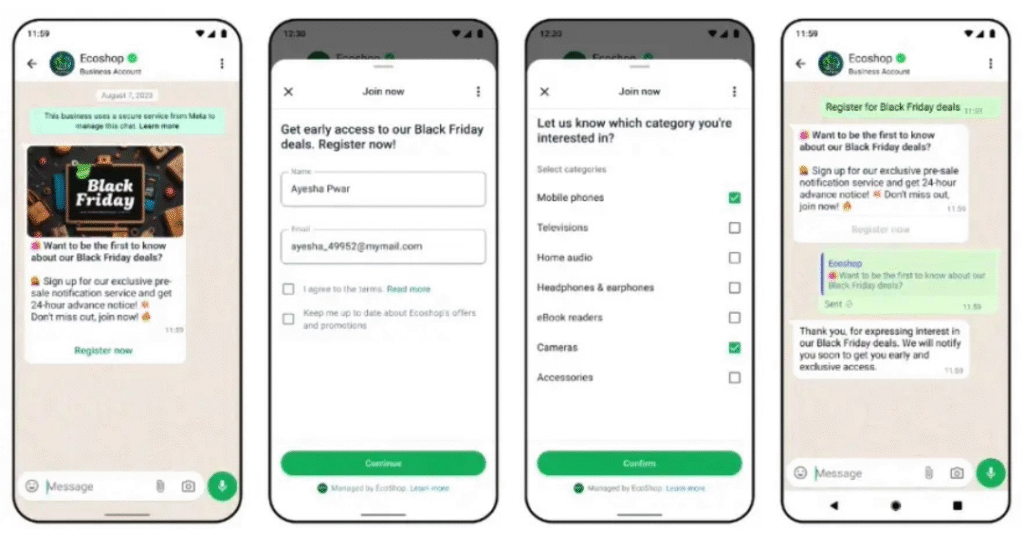WhatsApp is already a key channel for companies to offer support, answer customer questions, and maintain customer relationships. WhatsApp launched WhatsApp Flows in 2023, a new feature for WhatsApp Business designed to help define a conversation flow and maintain service quality.
A common challenge that companies face is the high abandonment rate in purchases when customers need to leave the chat to access an external website.
When there is no organized customer service script, conversations can get out of control, compromising the customer experience and damaging the company’s image. Therefore, having a well-defined conversation flow is essential for those who want to maintain quality customer service.
With that in mind, we will show you what WhatsApp Flows is, the advantages of this feature, and how to create an efficient message flow on WhatsApp, creating clearer, more agile, and more efficient communication with your audience.
What is WhatsApp Flows?
WhatsApp Flows is a feature available on the WhatsApp Business Platform that allows you to create interactive workflows directly within the app’s conversations.
With this tool, you can transform processes that previously required multiple messages into direct, fast, and more efficient interactions. This allows companies to build dynamic experiences within the chat, turning complex tasks into simplified steps.
Through WhatsApp Flows, you can create objective forms for collecting information, flows composed of multiple screens, and even real-time integrations that exchange data between systems. This offers customers a much more fluid and intuitive experience.
The big difference is that it reduces barriers to customer contact, preventing them from having to leave WhatsApp to complete important steps. This helps increase the completion rate, reducing abandonment.
Another strong point is flexibility: flows are fully customizable and can be adapted according to each company’s profile or business needs. With this, companies can create complete and personalized journeys within the same conversation, such as:
- Appointment scheduling and reservations
- Login or account authentication
- Choice of preferences or product customization
- Form filling and data collection
- Registration for promotions or participation in events

What are the benefits of WhatsApp Flows?
WhatsApp Flows offers several benefits for companies that want to optimize communication and strengthen customer relationships. From greater agility to a higher level of personalization in interactions.
Here are some of the main advantages of this WhatsApp message flow feature:
More agile customer service
With it, processes that used to be long and complicated can be converted into simple and intuitive steps, which speeds up service, saves customers time, and reduces the chance of abandonment during the process.
Resource savings
Task automation reduces the need for constant manual intervention, which helps lower costs and enables the business to grow without having to proportionally increase the size of the team.
Connection to internal systems
Another important advantage is the possibility of integrating WhatsApp Flows with APIs and internal systems already used by the company. This facilitates the sending and receiving of data in real time, keeping all information synchronized and improving overall operational efficiency.
Why invest in WhatsApp Flows for your customer service?
WhatsApp Flows was created to enable more dynamic and engaging interactions between businesses and customers, directly on the company’s WhatsApp. This feature helps in various areas, such as sales, marketing, customer service, and engagement, offering a more complete experience.
With custom flows, the main goal of WhatsApp Flows is to enhance the end-user experience, increasing business efficiency and generating greater satisfaction for those who interact with it.
More engagement in conversations
WhatsApp Flows enables companies to keep their audience engaged through notifications about news, quick opinion forms, or even sign-ups for promotions and events. All of this happens within the chat, without having to switch screens.
Tailored interactions
Another distinguishing feature is the ability to adapt flows according to user responses, creating personalized journeys that can improve conversion rates and encourage loyalty.
Practical and organized service
WhatsApp messaging has transformed customer support by allowing companies to develop structured processes within the app.
This includes automating responses to common questions and automatically directing more complex issues to human agents, ensuring agility and maintaining quality service.
This way, tasks such as scheduling appointments, conducting satisfaction surveys, or providing quick clarifications can be handled in the chat itself, without complications.
More qualified leads
By using WhatsApp Flows to collect relevant information such as budget, preferences, or specific needs, companies can better segment their contacts.
This means that only truly qualified leads, identified throughout the flow, are passed on to salespeople, optimizing time and increasing the chances of closing deals. This approach not only generates more consistent opportunities, but also helps the team focus their efforts on customers with the greatest potential.
How to use WhatsApp Flows in your business?
As an advanced resource for automating and personalizing communication with the public, WhatsApp Flows can be configured in different ways, varying in degree of complexity. Here are some of the main ways to put this tool into practice in your business:
Sending HSM messages
One of the most practical ways to get started is by using HSM messages. These are templates that have been pre-approved by WhatsApp and can be sent even if the customer has not initiated the conversation.
They are very useful for sending payment reminders, order status information, or important news, keeping the customer up to date.
Configuring flows via JSON
For those looking to set up more detailed interactions, WhatsApp offers the option to structure flows in JSON format. This feature allows you to define the complete logic of the flow: screens, fill-in fields, buttons, and navigation steps.
This makes it possible to build everything from complex forms to dynamic surveys, ensuring an interactive and personalized experience for the user.
Using webhooks
Webhooks function as monitoring points that allow you to track the performance of flows in real time. Through them, you can track indicators such as failures, status changes, or bottlenecks in the steps.
This information helps you quickly adjust processes, identify potential problems, and continuously improve the customer experience.
Integration with the streams API
Finally, the flows API enables companies to manage their flows programmatically. With it, you can create, update, or delete flows without relying on the visual configurator panel, which facilitates larger-scale projects or those that require direct integration with other internal systems. This makes management more agile, flexible, and automated.

